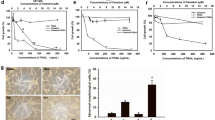Abstract
14-3-3 protein has emerged as critical regulators of diverse cellular responses. Previous studies found that strong 14-3-3 protein expression was observed and associated with tumor genesis and progression in glioma. Here, we further elucidated the role of 14-3-3 protein in apoptosis of human glioma U251 and U87 cells by global inhibition of 14-3-3 functions with a general 14-3-3 antagonist, difopein. In vitro, morphological observation and DNA laddering assay showed that difopein-treated glioma cells displayed outstanding apoptosis characteristics, such as nuclear fragmentation, appearance of membrane-enclosed apoptotic bodies and DNA laddering fragment. Moreover, flow cytometric detection of phosphatidylserine externalization indicated that difopein-induced apoptosis occurred in a time-dependent manner. Interestingly, inhibiting 14-3-3 with small interfere RNA also induce apoptosis of human glioma U251 cells. Furthermore, RT-PCR and western blot assay further substantiated that difopein had strong effects to induce glioma cell apoptosis through down-regulating Bcl-2, up-regulating Bax and activating caspase-9 and caspase-3. In vivo, retroviral vector was constructed and retroviral-mediated transfer of difopein to glioma was implanted in nude mice. Difopein effectively hindered proliferation and triggered apoptosis of tumor cells implanted into nude mice. This work not only reveals a critical role of 14-3-3 in apoptosis suppression in glioma cells, but also identifies and validates 14-3-3 as a potential molecular target for anticancer therapeutic development.





Similar content being viewed by others
References
Morrison DK (2009) The 14–3-3 proteins: integrators of diverse signaling cues that impact cell fate and cancer development. Trends Cell Biol 19:16–23
Lee JA, Park JE, Lee DH, Park SG, Myung PK, Park BC, Cho S (2008) G1 to S phase transition protein 1 induces apoptosis signal-regulating kinase 1 activation by dissociating 14–3-3 from ASK1. Oncogene 27:1297–1305
Nishino TG, Miyazaki M, Hoshino H, Miwa Y, Horinouchi S, Yoshida M (2008) 14–3-3 regulates the nuclear import of class IIa histone deacetylases. Biochem Biophys Res Commun 377:852–856
Obsilova V, Silhan J, Boura E, Teisinger J, Obsil T (2008) 14-3-3 Proteins: a family of versatile molecular regulators. Physiol Res 57(Suppl 3):S11–S21
Cao WD, Zhang X, Zhang JN, Yang ZJ, Zhen HN, Cheng G, Li B, Gao D (2006) Immunocytochemical detection of 14–3-3 in primary nervous system tumors. J Neurooncol 77:125–130
Rapp UR, Fischer A, Rennefahrt UE, Hekman M, Albert S (2007) BAD association with membranes is regulated by Raf kinases and association with 14–3-3 proteins. Adv Enzyme Regul 47:281–285
Cao WD, Zhang X, Zhang JN (2007) 14–3-3 protein and glioma prognosis. Chin J Exp Surgery (in Chinese) 24:377
Tzivion G, Gupta VS, Kaplun L, Balan V (2006) 14-3-3 Proteins as potential oncogenes. Semin Cancer Biol 16:203–213
Wang B, Yang H, Liu YC, Jelinek T, Zhang L, Ruoslahti E, Fu H (1999) Isolation of high-affinity peptide antagonists of 14–3-3 proteins by phage display. Biochemistry 38:12499–12504
Masters SC, Fu H (2001) 14–3-3 Proteins mediate an essential anti-apoptotic signal. J Biol Chem 276:45193–45200
Zamorano A, Lamas M, Vergara P, Naranjo JR, Segovia J (2003) Transcriptionally mediated gene targeting of gas1 to glioma cells elicits growth arrest and apoptosis. J Neurosci Res 71:256–263
Cortez N, Trejo F, Vergara P, Segovia J (2000) Primary astrocytes retrovirally transduced with a tyrosine hydroxylase transgene driven by a glial-specific promoter elicit behavioral recovery in experimental parkinsonism. J Neurosci Res 59:39–46
Jin N, Chen W, Blazar BR, Ramakrishnan S, Vallera DA (2002) Gene therapy of murine solid tumors with T cells transduced with a retroviral vascular endothelial growth factor–immunotoxin target gene. Hum Gene Ther 13:497–508
de Moraes MM, Dinguirard N, Franco GR, Yoshino TP (2009) Phenotypic screen of early-developing larvae of the blood fluke, schistosoma mansoni, using RNA Interference. PLoS Negl Trop Dis 3:e502
Fulda S, Debatin KM (2003) Apoptosis pathways in neuroblastoma therapy. Cancer Lett 197:131–135
Fulda S (2009) Apoptosis pathways and neuroblastoma therapy. Curr Pharm Des 15:430–435
Fulda S (2009) Tumor resistance to apoptosis. Int J Cancer 124:511–515
Brunelle JK, Letai A (2009) Control of mitochondrial apoptosis by the Bcl-2 family. J Cell Sci 122:437–441
Yip KW, Reed JC (2008) Bcl-2 family proteins and cancer. Oncogene 27:6398–6406
Luo J, Solimini NL, Elledge SJ (2009) Principles of cancer therapy: oncogene and non-oncogene addiction. Cell 136:823–837
Simpson CD, Anyiwe K, Schimmer AD (2008) Anoikis resistance and tumor metastasis. Cancer Lett 272:177–185
Townson JL, Naumov GN, Chambers AF (2003) The role of apoptosis in tumor progression and metastasis. Curr Mol Med 3:631–642
Acknowledgments
Supported by the National Natural Science Foundation of China (39970752) and Scientific and Technological Project of ShaanXi Province (2008K09-09). We gratefully acknowledge Michael Brenner (university of Alabama in Birmingham, USA) for providing pGfa2-LacZ plasmid, Wei Zhang (Biochemistry department in our university) for providing retroviral vector pLncx, and Haian Fu (Department of Pharmacology in Emory University, USA) for providing pSCM138 plasmid. We thank Jielai Xia’s (statistics department in our university) help in statistical analysis. We thank for Xiaoyan Chen (immune department in our university) assistance with flow cytometry, Angang Yang (immune department in our university) and Haian Fu for their comments on the manuscript. We thank Juan Li, Guo Geng, Wei Lin, Wei Zhang, LuHua Zhang, Yuhai Zhang and Jinxiang Chen for their helps in the process of major revision. And we also thank Junli Huo and Wanjuan Yang for material preparing for this research.
Conflict of interest statement
The authors declare that they have no conflict of interest.
Author information
Authors and Affiliations
Corresponding author
Additional information
The authors Weidong Cao and Xiaoliang Yang contributed equally to this work.
Electronic supplementary material
Below is the link to the electronic supplementary material.
Rights and permissions
About this article
Cite this article
Cao, W., Yang, X., Zhou, J. et al. Targeting 14-3-3 protein, difopein induces apoptosis of human glioma cells and suppresses tumor growth in mice. Apoptosis 15, 230–241 (2010). https://doi.org/10.1007/s10495-009-0437-4
Published:
Issue Date:
DOI: https://doi.org/10.1007/s10495-009-0437-4




